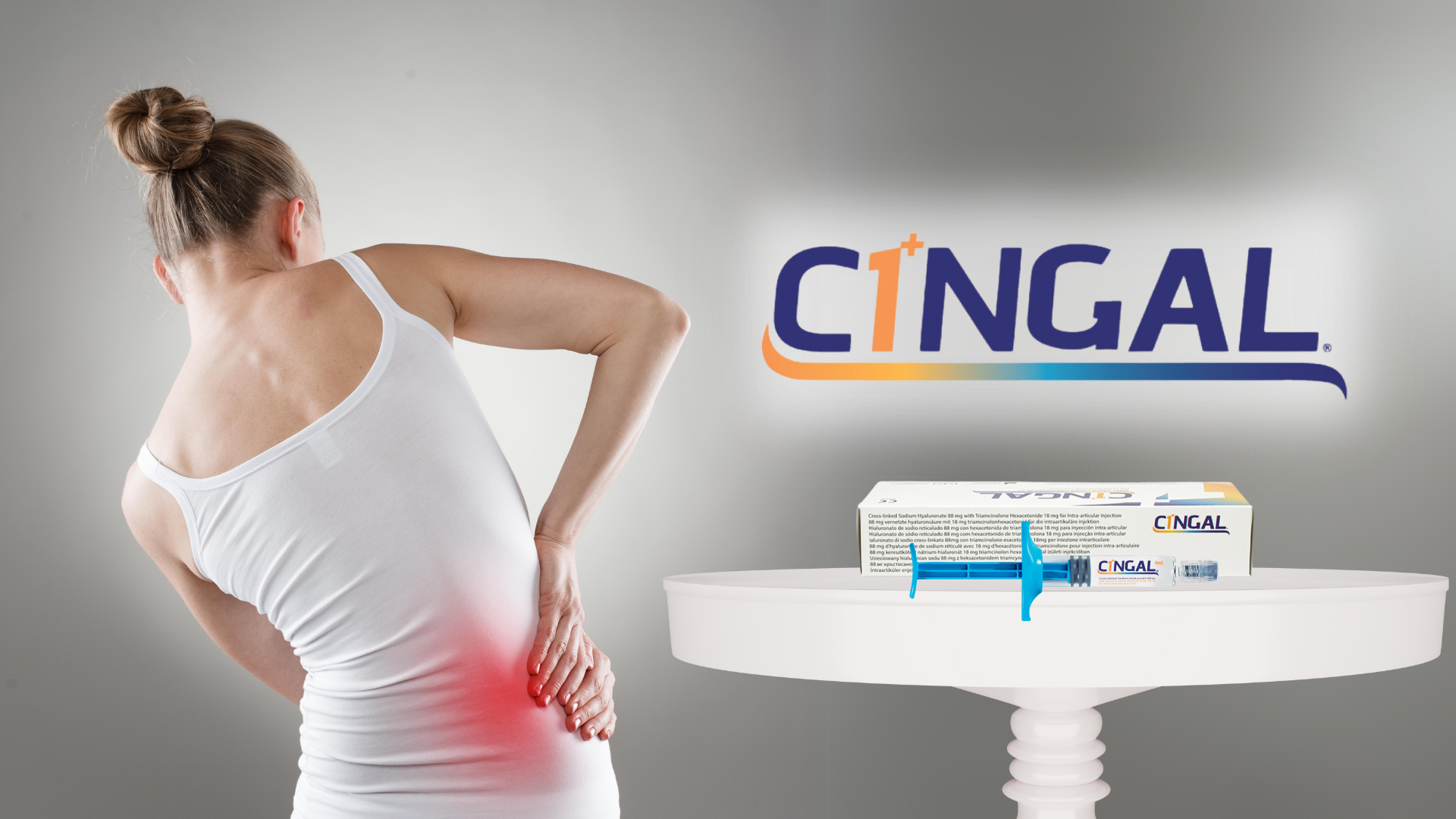SHARE THIS ARTICLE

Cingal
Exploring Cingal Hip Injections: A Comprehensive Review
Feb 15, 2024
Did you know that over 330,000 hip replacement surgeries are performed annually in the United States alone? Successful operations can improve patient’s quality of life and allow them to perform everyday activities. However, there are also significant risks associated with this surgical treatment. If a hip replacement surgery doesn’t go well the first time, patients may have to undergo operation again.
Osteoarthritis (OA), a type of arthritis that develops and worsens over time, can affect over 500 million people worldwide. Though it is common for this disease to grow in the knee, some people can experience OA in the hips. Cingal injection for hip pain has recently become popular because it delivers instant relief and heals the afflicted joint.
Learn more about Cingal hip injections as we explore this innovative treatment, highlighting their instant and long-lasting benefits for those struggling with hip pain.
Key Takeaways
- Cingal injections combine hyaluronic acid and a steroid to provide comprehensive relief for hip pain and inflammation.
- This innovative treatment option offers pain relief, improved joint function, and the potential to delay or avoid surgical intervention.
- Patients and healthcare providers should carefully consider eligibility, potential risks, and comparisons with other treatment options when exploring Cingal injections for hip-related issues.
- Cingal injections have shown positive outcomes in managing conditions such as hip osteoarthritis, joint degeneration, and postinjury rehabilitation.
- Clinical studies and patient experiences support the long-term effectiveness and sustainability of pain relief achieved with Cingal injections.
Understanding Cingal Hip Injections
Cingal injections combine cross-linked hyaluronic acid (HA) and a quick-acting steroid called triamcinolone hexacetonide. This mixture helps people who experience pain in their hips because of osteoarthritis, leading to pain relief and improved joint function.
HA is a substance that is naturally produced by the body. In Cingal injections, HA works like oil to help the hip joint move smoothly and provide cushioning. On the other hand, the steroid in Cingal’s formulation acts fast to reduce swelling and pain.
The combination of hyaluronic acid and a steroid in Cingal sets it apart from traditional hyaluronic acid injections or corticosteroid injections. This dual-action formulation aims to address both the symptoms and the underlying causes of hip pain, offering a more comprehensive approach to treatment.
Patients often turn to this treatment when regular over-the-counter painkillers don’t work well enough or if they want to avoid surgery and the risks that come with it.
Mechanisms of Action
Licensed practitioners administer Cingal directly into the hip joint so it can glide smoothly. While delivering fast results, Cingal injections provide longer-lasting relief from osteoarthritis symptoms than many other treatments.
Cingal also allows people to perform everyday activities, such as walking, bending, or sitting, more comfortably after the injection. This treatment can also save them from needing surgery immediately by keeping the hips working well without as much hurt.
Benefits of Cingal Hip Injections
Cingal injections are a promising option for patients with hip pain due to osteoarthritis who have not found adequate relief from other treatments. Combining hyaluronic acid and corticosteroids, Cingal can offer the following benefits:
- Pain Relief and Inflammation Reduction: Cingal hip injections offer quick pain relief and reduce swelling. They work fast, easing pain in just a few days after a single shot. Doctors see this as a big win because it means less use of strong painkillers like opioids.
- Improvement in Joint Function and Mobility: People with osteoarthritis in their hips find walking, climbing stairs, and doing other daily things easier after getting Cingal injections. Clinical studies show that these shots improve how well your hip works and get you moving again more comfortably. Cingal hip injections are changing how we help people with painful joints.
- Potential to Delay or Avoid Surgical Intervention: This treatment has shown promise for those with osteoarthritis in the hip joint. Many people with hip pain worry about needing surgery, but Cingal hip injections can change that for some patients. They offer a way to handle pain and could help you wait longer before having an operation.
Considerations for Cingal Hip Injections
When considering Cingal hip injections, evaluating who benefits most from this treatment and weighing potential risks is essential. A discerning look at the broader picture ensures informed decisions.
Patient Eligibility and Candidacy
Not all patients with hip pain may be suitable candidates for Cingal injections. Healthcare providers will assess factors such as the severity of the condition, medical history, and previous treatment outcomes to determine if Cingal is an appropriate option.
Potential Side Effects and Risks
Selecting suitable patients for Cingal hip injections is crucial. Yet, even with careful screening, there are risks and side effects to consider.
- Injection site pain, rash, redness, or swelling
- Joint pain or stiffness
- Water retention and swelling
- Spots or discoloration of the skin
- Allergic reaction or infection
These side effects are usually mild and temporary and resolve without treatment. However, you must contact your doctor if they persist or worsen.
Comparison With Other Hip Pain Management Options
Having discussed the potential side effects and risks associated with Cingal hip injections, it’s crucial to understand how Cingal compares to other hip pain management options available to patients.
Choosing an effective treatment can be pivotal in managing hip pain for both short-term relief and long-term health.
| Treatment Option | Mechanism of Action | Effectiveness | Potential Side Effects | Duration of Relief | Candidate Suitability |
Cingal Hip Injections | Combination of hyaluronic acid and corticosteroid | Superior pain reduction | Mild to moderate, similar to corticosteroids | Varies; most patients report long-lasting relief | Patients with osteoarthritis and joint degeneration |
Corticosteroid Injections | Anti-inflammatory action | High effectiveness for short-term pain management | Potential joint damage with repeated use | Medium-term | Wide range of inflammatory joint conditions |
Viscosupplementation (Hyaluronic Acid) | Lubricates and cushions the joint | Small reduction in pain intensity | Minimal side effects; risk of joint swelling and pain | Medium term | Patients with mild to moderate osteoarthritis |
These comparisons underline Cingal’s place in the spectrum of osteoarthritis-related pain management. Clinicians must weigh each option’s benefits and drawbacks before proceeding with a personalized treatment plan for their patients.
Applications of Cingal Hip Injections
- Hip Joint Degeneration: Hip degeneration occurs when the cartilage in the joint wears out, causing bones to rub and hurt. This makes activities or movements like walking or sitting difficult and painful. Cingal may help people with hip degeneration cope better, reducing pain and damage and improving hip function.
- Postinjury Rehabilitation: Following hip injuries, Cingal injections may aid rehabilitation by reducing inflammation and promoting better joint mobility, allowing patients to recover more effectively.
Outcomes and Success Rates
Three phase III clinical trials prove the efficacy and safety of Cingal injections. They provide rapid and long-lasting pain relief that can last up to six months with just one injection. These trials compared Cingal to treatment options like saline injections or hyaluronic acid alone.
The results of the trials showed that Cingal injections provided rapid and long-lasting pain relief that can last up to six months. Cingal also improved joint function and mobility. Moreover, they had a low risk of side effects and complications and were well-tolerated by most patients.
Clinical studies also confirmed the safety of a repeat injection using Cingal. There were no serious adverse events related to the injection, and the most common side effects, like injection site pain or swelling, disappeared after the treatment.
Patient Testimonials and Experiences
People with pain caused by osteoarthritis (OA) have shared their experiences using Cingal injections. Most patients say these shots helped with knee and hip pain, as Cingal allowed them to move better and feel less pain after the injection.
One patient, Gary, is a motorsport enthusiast who sought Cingal to treat OA in his knee. Although he’s had several shots of Monovisc in the past, he needed a better and stronger treatment to provide rapid relief so he could still participate in his motorsport events.
After receiving Cingal in both knees, he shared how he felt no pain. With Cingal, he was as mobile and flexible as ever. Gary also added that Cingal allowed him to strengthen and protect his knees for the long term.
Dr. Olufemi Ayeni has also shared his experience administering Cingal injections to relieve knee and hip pain. His patients were usually those who weren’t candidates for hip replacement surgeries or those who felt like prescription medicine wasn’t effective anymore.

Dr. Ayeni praises the innovative formulation as its anti-inflammatory and hyaluronic acid (HA) components are like hitting two birds with one stone. Cingal hyaluronic acid injections have proven reliable and effective compared to other orthopedic treatments Dr. Ayeni used in the past, as they provide instant and long-lasting relief.
Finally, the Cingal 13-01 trial noted how patients saw a significant drop in the pain they experienced before getting Cingal. The results showed how the injections reduced joint pain by 72% six months after their initial treatment, showing promising outcomes for future Cingal hip injection reviews.
Conclusion
Cingal injections are a promising treatment for hip osteoarthritis, which causes pain and stiffness in the hip joint. Combining hyaluronic acid and a steroid, Cingal provides comprehensive benefits encompass pain relief, inflammation reduction, and enhanced joint mobility.
Patients, caregivers, and healthcare professionals can learn how Cingal works, its benefits and risks, and who can benefit from it.
Cingal injections offer a viable alternative to surgery for some patients with hip osteoarthritis.
About: Since 2014, Maylips has garnered trust from over 2,000+ global clients, becoming the go-to supplier of cosmetic, skincare, and orthopedic products for medical and aesthetic professionals, including providing transparent Cingal injection cost details. Our expansive selection offers authentic brand-name products at competitive wholesale prices, ensuring practices have access to everything from dermal fillers and botulinum toxins to mesotherapy, PRP kits, and more. As your ally, Maylips is more than a supplier; we are dedicated to supporting your journey towards medical and aesthetic excellence with top-quality products and unparalleled customer service.
FAQs
1. What is a Cingal injection shot, and what does it do?
A Cingal injection shot is a type of treatment for pain caused by osteoarthritis, a condition that wears out the cartilage in the joint. A Cingal injection shot combines hyaluronic acid (HA) and triamcinolone hexacetonide. HA is a natural substance that lubricates and cushions the joint, while triamcinolone hexacetonide is a steroid that reduces inflammation and pain.
2. How does Cingal stack up against cortisone shots?
Cingal and cortisone shots are both types of injections that can help relieve pain and inflammation in the joints caused by osteoarthritis. However, they have some differences in their composition and duration. Cingal may offer more comprehensive benefits than cortisone shots, as it can address both pain and damage in the joints. It is also a single-injection treatment, unlike cortisone shots that are given as a series of injections.
3. How long do results from Cingal last?
Cingal injections provide results that can last up to six months or more. However, the duration of the results may vary depending on the individual condition and response of the patient. Some patients may need one or more injections to achieve optimal results, and Cingal has been proven safe for retreatment.
4. Will it hurt if I get Cingal injections?
Like any treatment involving injections, Cingal shots may cause some pain or discomfort at the injection site. You can always ask your doctor if they can administer anesthesia to the joint first to help make the procedure more comfortable and tolerable. Following the treatment, patients may feel side effects like swelling, redness, or pain in the injection site, which are usually mild and temporary.
5. Can I use Cingal in other joints?
Doctors mainly use Cingal injection for knee pain, helping relieve the afflicted joint so patients can walk and move better.
References
Hip Replacement (Hip Arthroplasty). Cleveland Clinic. https://my.clevelandclinic.org/health/treatments/17102-hip-replacement Hangody LR, Szody R, Łukasik P, et al. Intraarticular Injection of a Cross-Linked Sodium Hyaluronate Combined with Triamcinolone Hexacetonide (Cingal) to Provide Symptomatic Relief of Osteoarthritis of the Knee: A Randomized, Double-Blind, Placebo-Controlled Multicenter Clinical Trial. CARTILAGE. 2017;9(3):276-283. doi:10.1177/1947603517703732




